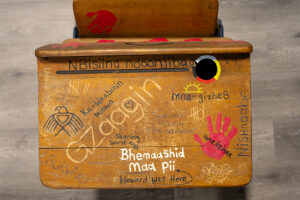Desk art installation a different way of honouring Survivors
Trigger warning: readers may be triggered by the subject matter of Indian Residential Schools. To access a 24-hour National Crisis Line, call: 1-866-925-4419. Community Assistance Program (CAP) can be accessed for citizens of the Anishinabek Nation: 1-800-663-1142

By Marci Becking
NIPISSING FIRST NATION – There is something powerful about seeing an old wooden school desk – the kind that has metal on the bottom of them similar to the old Singer sewing machines. Les Couchi says that they were metal on the bottom so that they could be bolted to the floor.
Couchi, a citizen of Nipissing First Nation, explains how he came up with the idea for a different way to honour those who attended Indian Residential Schools.
“On my many daily photography tours around Nipissing Nation, I would pass the Residential School Memorial. The memorial is a typical one of stone and an etched plaque with names of the children who went there, to be incarcerated during their childhood,” says Couchi. “The memorial lacked any emotion — it doesn’t provoke, evoke, cause anger, enrage, or infuriate the senses. On this one occasion, I thought, ‘What if there was a school desk from those days?’ Something that would move the viewer to shed a tear, pry open a cold heart, cause them to reflect on the values of this country. Something that would create a new perspective on our history.”
Thus began Couchi’s journey with the Residential School Desk Project to be featured as an exhibit at the North Bay Museum starting on July 17.
“’How do we get there?’ was the next question for me. I will need desks,” recalls Couchi.
Karen Miller-Pitman, John Pitman, Tom Slack of Bonfield, and Jean Marc Levesque of West Nipissing donated desks to the project.
After getting the desks, it was up to Nipissing First Nation artists Don Chretien, Sean Couchie, Brady Penasse, Alexandra Couchie, Paulette Chretien, and craftsperson Tracey Larochelle to add their creativity.
“All agreed to help with the project, bringing their unique artistic talents to the table,” says Couchi. “I never told them how to do it. It was up to the artist to give their interpretation.”
One double desk was done with butterflies by Sean and Alexandra Couchie.
“The black butterflies represent the kids that didn’t go home,” says Couchi.
Brady Penasse’s desk looks like a student’s design with carvings etched into the wood and words written on the desk. His grandfather Howard-baa attended Spanish Residential School and Brady decided to etch “Howard was here” as a tribute to him.
“My grandfather took his mother’s last name, Penasse, even though his father was a Commanda,” says Penasse, who assumes his grandfather did this since he started school after his mother passed.
Howard-baa faced challenges very early on in his life as he would have been six or seven at the time when his mother passed and his father was never in his life.
“He stayed at Spanish all year long, never leaving for Christmas break like the other Survivors because he didn’t have his father in his life. So, I heard that he attended Residential School until he aged out of the system at age 18.”
Penasse’s desk also has small hand prints on the seat – he says that these were made by Ziigwan Fisher, Penasse’s niece who also is Howard-baa’s great-granddaughter.
Another desk was done all in copper by Don Chretien. It is trimmed with tiny moccasins made by Shirley Renaud of Dokis First Nation just before she passed earlier this year.
Couchi received financial support from Natalie Payette-Chevrier and her partner Doug Chevrier who both have many successful businesses in Nipissing First Nation.
“Joan McLeod, a councillor for Nipissing First Nation, was informed of the project and she brought the First Nation into the fold. Joan, like many of us on the First Nation, know first-hand about the Residential Schools and intergenerational aspects that have plagued our community for years,” says Couchi.
The North Bay Museum staff, Grace Armstrong and Naomi Hehn, came on aboard to help give this project a public forum for everyone to see.
“The [exhibit is a] culmination of an idea, artistic interpretations, and the generosity of business and community working together,” says Couchi.
The ceremonial opening will be held on July 21, 2023, from 11: 00AM EST to 1:00 PM EST. The exhibit will run from July 17 until the first week of September.


